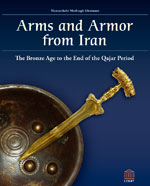|

|
1|2|3|4|Contents
ARMS AND
ARMOR FROM IRAN (4)
The
Bronze Age to the End of the Qajar Period
Ancient Iranian Images
Many ancient Iranian images continued to be used into
the Qajar period. One of the most famous that appears as
a decorative motif on some arms is the fighting scene
between a lion and a bull. The meaning of this emblem is
investigated and based on references, an explanation of
its significance is presented. The emblem appears on the
forte of double-edged, curved daggers (khanjar). A
number of
 Iranian
khanjar with carved ivory handles are also illustrated.
The carved images show an interesting variety of ancient
heroes such as Shahname, Sassanian kings, and some
Europeanized images (farangisazi). Other types of
Iranian small arms, such as the kard (knife) and
pishqabz (a dagger with a single-edged, double-curved
blade), are shown, and the different styles of these
weapons are discussed. Included are discussions of other
types of weapons, such as maces (gorz), axes (tabar),
spears (neyze), and shields (separ). The developmental
chronology of each weapon is analyzed from the bronze
era up to the end of the Qajar era. For example, the
significance of the Iranian
khanjar with carved ivory handles are also illustrated.
The carved images show an interesting variety of ancient
heroes such as Shahname, Sassanian kings, and some
Europeanized images (farangisazi). Other types of
Iranian small arms, such as the kard (knife) and
pishqabz (a dagger with a single-edged, double-curved
blade), are shown, and the different styles of these
weapons are discussed. Included are discussions of other
types of weapons, such as maces (gorz), axes (tabar),
spears (neyze), and shields (separ). The developmental
chronology of each weapon is analyzed from the bronze
era up to the end of the Qajar era. For example, the
significance of the
 bull-headed
mace is considered. Similar examples from Marlik are
shown and the general relevance of the cow and bull in
Zoroastrianism are examined. One chapter is dedicated to
the martial arts and warrior training in Iran. Included
in this chapter is the training of ancient warriors,
traces of which are still evident in varzesh bastani
(the ancient sport) that is practiced in zurkhane (house
of strength). Based on historical manuals and
chronicles, some techniques of Persian swordsmanship are
also discussed. bull-headed
mace is considered. Similar examples from Marlik are
shown and the general relevance of the cow and bull in
Zoroastrianism are examined. One chapter is dedicated to
the martial arts and warrior training in Iran. Included
in this chapter is the training of ancient warriors,
traces of which are still evident in varzesh bastani
(the ancient sport) that is practiced in zurkhane (house
of strength). Based on historical manuals and
chronicles, some techniques of Persian swordsmanship are
also discussed.

back
| more |




